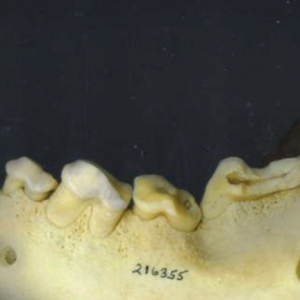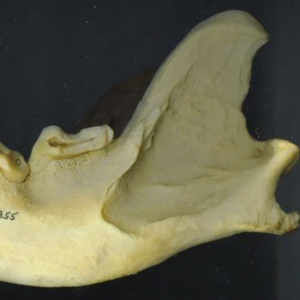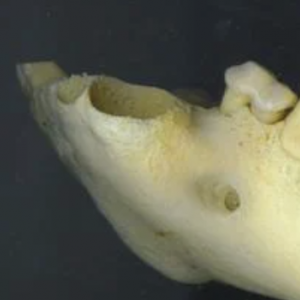Relationship between tooth macrowear and jaw morphofunctional traits in representative hypercarnivores
The mammalian adult dentition is a non-renewable resource. Tooth attrition and disease must be accommodated by individuals using behavioral, physiological, and/or musculoskeletal shifts to minimize impact on masticatory performance. From a biomechanical perspective, the musculoskeletal system becomes less efficient at producing bite force for a given amount of muscle input force over an individual’s life, because tooth-food contact area increases as cusps wear.
In the Press

Hypercarnivores study reveals unique adaptations of jaw function and tooth wear
Phys.org

New study reveals unique adaptations of jaw function and tooth wear in hypercarnivores
All Sides
.

How Ancient and Modern Predators Cope with Worn-Out Teeth
Science Blog
“Once grown, adult teeth in living mammals are irreplaceable and have to last their entire lives. For top predators that rely on their teeth to acquire and process food, we wondered if changes in feeding performance from dental ‘wear and tear’ were compensated for by how the jaw mechanically resists stress from biting. We discovered that living predators and the extinct Hyaenodon may have used different biomechanical strategies to compensate for worn teeth.”
Dr. Jack Tseng
For All Readers - AI Explainer
What is this research about, and why is it significant?
This study examines how tooth wear affects jaw performance in hypercarnivores—animals that rely heavily on meat. By studying species with different feeding habits, like bone-cracking hyenas and meat-specialist felines, researchers sought to understand how tooth wear influences jaw efficiency and what adaptations (if any) occur to maintain their feeding ability. This has implications for understanding both modern and ancient carnivores’ dietary adaptations and survival strategies.
Why focus on tooth wear and jaw mechanics in hypercarnivores?
Since mammalian teeth don’t regrow, wear and tear are inevitable as carnivores age. Understanding how jaw mechanics and tooth wear impact bite force and feeding behavior can help researchers better assess how these animals adapt as they age and how their physical changes influence their survival strategies.
What were the key findings about jaw mechanics and tooth wear?
Surprisingly, most of the studied hypercarnivores showed no major structural changes in their jaw over time despite tooth wear. However, bone-cracking scavengers, like spotted hyenas, showed increased mechanical efficiency when biting with worn carnassial teeth (the large back teeth used to crush bones), without significant additional stress on their jaws. This adaptation wasn’t seen in pure meat specialists like big cats, suggesting that these species rely more on behavioral changes than mechanical compensation as they age.
How does this study shed light on ancient carnivores like Hyaenodon?
The extinct Hyaenodon, once thought to share jaw mechanics similar to modern hyenas, showed a unique increase in efficiency with worn canines. This trait sets it apart from living hypercarnivores, suggesting that Hyaenodon had its own adaptations that don’t perfectly align with today’s species. Such findings encourage more detailed studies on extinct species rather than assuming similarities with modern animals.
Why do meat specialists, like large cats, lack mechanical compensation for tooth wear?
Meat specialists have jaws that are optimized for slicing rather than crushing, so they don’t rely as much on worn teeth. Instead, as their teeth wear down, they likely adapt behaviorally—like altering hunting strategies or targeting softer prey—to maintain feeding success, rather than undergoing physical changes in jaw structure or efficiency.
What does this research suggest about feeding strategies over an animal’s lifetime?
The study reveals that feeding strategies may evolve with age, with animals adjusting behavior or taking advantage of subtle mechanical changes in their jaws to compensate for tooth wear. This challenges the notion that an animal’s feeding ecology is fixed and suggests that adaptations may be more fluid, adjusting with wear and age, which could be a source of natural selection.
How does this study add to our understanding of ancient carnivore communities?
This research highlights how tooth wear and jaw mechanics could have influenced survival and feeding strategies across generations of carnivores. By understanding these wear-dependent performance changes, paleontologists can better interpret the ecological roles and adaptive strategies of ancient carnivores in their environments.
What’s next for this line of research?
Future studies may explore other carnivore species to see if similar patterns emerge across different ecosystems. Researchers may also look into how behavioral shifts correlate with mechanical changes, providing further insight into how animals adapt to aging and environmental pressures in both modern and fossilized species.
Relationship between tooth macrowear and jaw morphofunctional traits in representative hypercarnivores
The mammalian adult dentition is a non-renewable resource. Tooth attrition and disease must be accommodated by individuals using behavioral, physiological, and/or musculoskeletal shifts to minimize impact on masticatory performance.
What are Article Spotlights?
Spotlighted articles are press released, and feature author interviews, AI explainers and more.
If you have published in Peer J and would like to be featured in an Article Spotlight please contact PeerJ.

